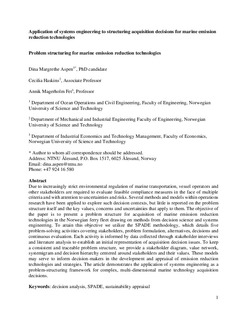| dc.contributor.author | Aspen, Dina Margrethe | |
| dc.contributor.author | Haskins, Cecilia | |
| dc.contributor.author | Fet, Annik Magerholm | |
| dc.date.accessioned | 2019-02-20T10:17:20Z | |
| dc.date.available | 2019-02-20T10:17:20Z | |
| dc.date.created | 2018-11-08T13:16:58Z | |
| dc.date.issued | 2018 | |
| dc.identifier.citation | Systems Engineering. 2018, 21 (4), 388-397. | nb_NO |
| dc.identifier.issn | 1098-1241 | |
| dc.identifier.uri | http://hdl.handle.net/11250/2586480 | |
| dc.description.abstract | Due to increasingly strict environmental regulation of marine transportation, vessel operators and other stakeholders are required to evaluate feasible compliance measures in the face of multiple criteria and with attention to uncertainties and risks. Several methods and models within operations research have been applied to explore such decision contexts, but little is reported on the problem structure itself and the key values, concerns, and uncertainties that apply to them. The objective of the paper is to present a problem structure for acquisition of marine emission reduction technologies in the Norwegian ferry fleet drawing on methods from decision science and systems engineering. To attain this objective, we utilize the SPADE methodology, which details five problem‐solving activities covering stakeholders, problem formulation, alternatives, decisions, and continuous evaluation. Each activity is informed by data collected through stakeholder interviews and literature analysis to establish an initial representation of acquisition decision issues. To keep a consistent and traceable problem structure, we provide a stakeholder diagram, value network, systemigram, and decision hierarchy centered around stakeholders and their values. These models may serve to inform decision‐makers in the development and appraisal of emission reduction technologies and strategies. The paper demonstrates the application of systems engineering as a problem‐structuring framework for complex, multidimensional marine technology acquisition decisions. | nb_NO |
| dc.language.iso | eng | nb_NO |
| dc.publisher | Wiley | nb_NO |
| dc.title | Application of systems engineering to structuring acquisition decisions for marine emission reduction technologies | nb_NO |
| dc.type | Journal article | nb_NO |
| dc.type | Peer reviewed | nb_NO |
| dc.description.version | acceptedVersion | nb_NO |
| dc.source.pagenumber | 388-397 | nb_NO |
| dc.source.volume | 21 | nb_NO |
| dc.source.journal | Systems Engineering | nb_NO |
| dc.source.issue | 4 | nb_NO |
| dc.identifier.doi | 10.1002/sys.21445 | |
| dc.identifier.cristin | 1628365 | |
| dc.relation.project | Norges forskningsråd: 225356 | nb_NO |
| dc.description.localcode | Locked until May 28th 2019 due to copyright restrictions. This is the peer reviewed version of an article, which has been published in final form at https://doi.org/10.1002/sys.21445. This article may be used for non-commercial purposes in accordance with Wiley Terms and Conditions for Self-Archiving. | nb_NO |
| cristin.unitcode | 194,64,93,0 | |
| cristin.unitcode | 194,64,92,0 | |
| cristin.unitcode | 194,60,25,0 | |
| cristin.unitname | Institutt for havromsoperasjoner og byggteknikk | |
| cristin.unitname | Institutt for maskinteknikk og produksjon | |
| cristin.unitname | Institutt for industriell økonomi og teknologiledelse | |
| cristin.ispublished | true | |
| cristin.fulltext | postprint | |
| cristin.qualitycode | 2 | |
